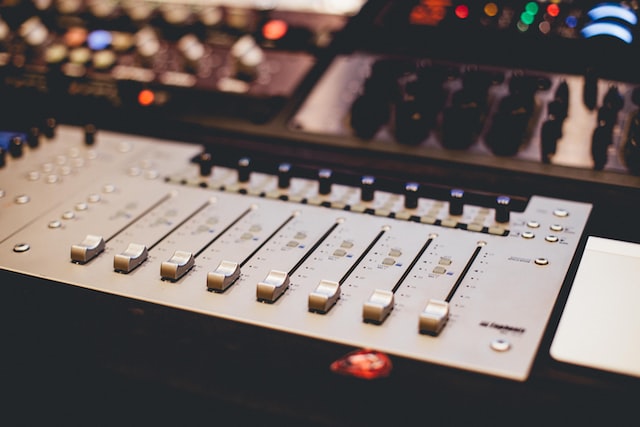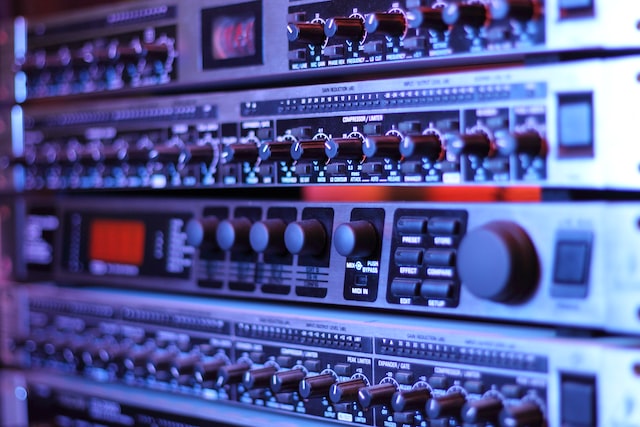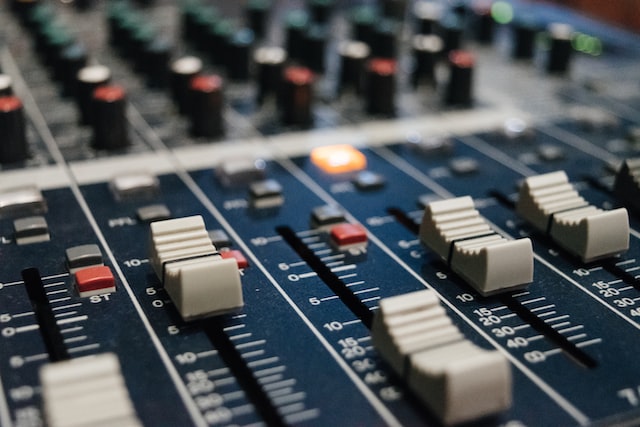BecomeSingers is reader-supported. When you buy through links on our site, we may earn an affiliate commission. Learn More
If you’re running out of inputs to connect all your mics and instruments, using a mixer is a great option. But it can be quite complicated: so many wires and so many inputs and outputs tend to get confusing real quick. And if you get it wrong, you’ll suffer from poor audio, noise, distortion, or worse – no sound at all. Even the pros slip up sometimes, so don’t worry.
I’ve created a quick guide on how to connect a mixer to your audio interface, with tips from my personal experience to ensure you get the best sound possible. Plus, I’ve shared some troubleshooting advice in case you run into any problems along the way.
Table of Contents
How to connect Mixer to Audio Interface?
Connect the stereo output of the mixer to the line input of the audio interface using balanced TRS or XLR cables. Connect some mics and instruments to the mixer. Set up the audio interface inside your DAW and create multiple tracks. Balance the volumes on your mixer to get a good sound.
But if you’re not sure if you have the right cables or you’re still facing issues, read on to see my tips for getting a reliable sound and how you can fix noise and buzz.
Step-by-Step Guide to Connecting a Mixer Board to an Audio Interface

Equipment Needed
- Mixer
- Audio Interface
- Cables (TRS or XLR)
- Microphones and Instruments
- Studio Monitors
- Computer
- DAW
1. Connect the audio interface to your computer
First, you must connect your audio interface to your computer and set it up properly. Make sure you’re using a short, appropriate cable (USB, Thunderbolt, etc.) for the interface, and have the latest drivers installed.
You should test to see if it’s working by connecting a mic or instrument to it and recording something in a DAW. This’ll help troubleshoot any other problems you may face while connecting the mixer.
2. Connect the output of the mixer to the line input of your audio interface using a TRS or XLR cable
Now, connecting the mixer to the interface is as easy as finding the right cable for it. Check the output port of the mixer and the line input of the audio interface. It’s important to use a line input because most mixers output a line-level signal.
The output on a mixer is usually labeled OUT (L and R) or something along that. Make sure there are two different output channels, using two cables so that you get full stereo flexibility while recording and mixing.
Most mixers nowadays have ports for both XLR and TRS (¼”). I recommend using balanced XLR cables if you can, as they have the best audio quality and the lowest noise levels. But if you prefer TRS, you can use balanced TRS cables too.
Just try to use gold-plated, balanced, and short cables. I definitely don’t recommend using unbalanced or TS cables, as this will increase the noise and interference in your recording.
So accordingly, connect the L output of the mixer to the L input of the audio interface and the R output to the R input. Since an interface’s line-level inputs don’t have gain knobs, the gain will be set for each channel using the mixer itself.
3. Connect a few microphones or instruments to the mixer
Now, connect a few mics or instruments like guitars and keyboards to the mixer so you can test it. Mixers usually have several channels, but not all will have preamps. So again, you need to check whether you need a preamp or not.

Most microphones, acoustic guitars, and even some electric guitars need a preamp, as this will add gain to the signal and bring it up to a proper recording line level. Without one, you’ll get a thin, weak sound.
So for these, use the channels on your mixer that have a preamp (usually the first few), and adjust the gain knob to get a good, strong signal that doesn’t clip (shown as red, above 0 dB).
Keyboards, guitar pedal outputs, and many other electronic instruments often output a line-level signal already, so you can just use any line-level input of the mixer. There’s no gain knob on these, so it’s more straightforward.
4. Turn on both devices and open your DAW
Now, turn on both the mixer and the audio interface (connect the power cables in case you haven’t), and fire up the DAW on your computer.
Configure the audio interface with an appropriate sample rate and buffer size (I recommend starting with 44.1 kHz and 256 samples, but this varies). Set up two tracks in the DAW, each with one L or R input from the mixer.
This way, the stereo output from the mixer will go into its own track, so you can mix in stereo later, giving you much more flexibility over your music.
On a side note, some mixers do support multichannel output, but for this, you’ll require an interface that has just as many channels. That leads to several cables too. This gives even more flexibility over each instrument, so you can experiment with that if it supports this.
5. Test the sound by slowly increasing the volume
Now that everything is connected, powered on, and your DAW is ready, you can test if your setup is working. Start with all the volume knobs at zero. Remember, the master volume knob on your audio interface will control the overall output volume.
Turn up the mixer’s volume, and check for a signal in your audio interface’s meter (make sure it’s not clipping or showing red). Now you can turn up the interface’s volume slowly and listen to the audio.
Make sure you have ‘Record Monitoring’ armed and ready in your DAW tracks, or you may not get any sound. You can also monitor the recording levels using the DAW’s in-built meters.
Sing or play through each mic or instrument connected to your mixer to see if it’s working well, and you should be getting a strong output without noise, hums, or unnecessary distortion.
6. Adjust the volume and gain on your mixer to get a good balance
Now that everything is tested and working, it’s time to finally put that mixer to good use! Every mixer model has a range of different controls, so you’ll have to check yours accordingly.

To note, the output volume knob on your mixer essentially controls the input gain of the audio interface: it should be just strong and stable enough without clipping. On the other hand, the gain of the mixer’s preamp adds distortion and power to your mic/instrument.
So you should set up the gain first to get a good sound from your mic and then use the volume on your mixer to fine-tune.
If your mixer has onboard effects like Compression, Reverb, Delay, or anything else, you can set them up to taste. Just start with small amounts and increase them slowly so you can judge what sounds best to your ears.
Tips For Troubleshooting And Getting The Best Sound From Your Mixer
A typical setup looks like mic > mixer > audio interface > computer > studio monitors, which is quite complicated and increases the chances of something going wrong. So here are things to look out for and make sure you’re getting the best sound:
- Check that all your cables are tightly connected, with no loose or frayed ends. Try to use gold-plated plugs and short cables to optimize the sound.
- Make sure you’re using balanced cables to connect the mixer, audio interface, and studio monitors. Generally, most XLR cables are balanced, and a balanced TRS cable has two black lines on its plug, so you can easily identify it.
- Set appropriate gain and volume levels on the mixer and audio interface. Start with lower levels and don’t push either of them too loud, but you can experiment a bit to find what sounds best to your ears.
- Adjust the audio interface settings. The sample rate and buffer size make a significant impact on the quality and latency, but there’s no fixed rule on what’s best. So you can try a couple of different ones to see what works best on your system. If you have too much latency, try to reduce the buffer size.
- Turn off any onboard mixer effects if you suspect that they may be causing an issue. In most cases, you can add these effects later on in your DAW too.
- Organize all your cables neatly. With so many cables flying around, it’s easy to make a mess of it, and different cables overlapping and crossing each other leads to more noise and interference. So use cable ties to organize any excess length of the cable.
In case you have problems, you should troubleshoot each component individually. For example, test the mixer direct to your studio monitors, test a mic direct to your audio interface, or test the cables one by one. This helps you figure out which part is causing the issue.
Another tip: if your interface has ‘Direct Monitoring’, turn that on and check if the direct sound has any issues or not. If it does, the problem is likely with the mixer’s connection.
Check out are article on ‘Best Studio Monitor Amplifiers’.
FAQs
Can you use a mixer and audio interface at the same time?
Can I connect the mixer directly to Speaker?
How do I connect my mixer to my computer for recording?
To connect a mixer to your computer for recording, you need a USB sound card or audio interface first. If your mixer already has a USB output, you can use that, but most models don’t. So you connect it to an audio interface first and then connect the interface to a computer to be able to record your music in a DAW.
Conclusion
Setting up a mixer with an audio interface can be a confusing process. However, having the right cables and taking the time to set up each device properly is key for recording quality sound. Don’t get disheartened if you run into issues while setting up; even the pros make mistakes. Just be patient and ensure you’ve followed each step I’ve outlined, and keep checking your settings along the way.
If this guide helped you, feel free to share it with any friends who could benefit from it. And feel free to send in any questions or suggestions you have!





